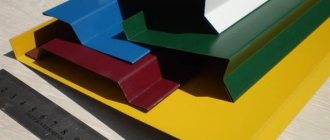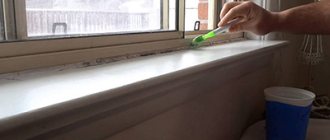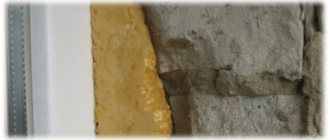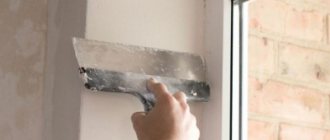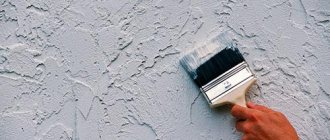Recently, residents of cities and even small villages prefer plastic windows. But it would be wrong to think that the wooden window has completely disappeared from modern life. There are people who, for some reason, left the old windows, and there are also sincere supporters of wooden frames. Wooden windows cannot last long without such an essential element as putty. Yes, and for plastic windows it is relevant. Therefore, you should understand in more detail what window putty is.
Purpose of putty for windows
Window putty is a thick paste that is applied to the junction of the glass and the frame. Its necessity is to provide a certain level of tightness, as well as greater strength of the connection between the glass and the frame. It is also required to seal the joints of frame parts. Putty for wooden windows is also required to cover small cracks in the frames.
In plastic windows, glass does not often come off the frame, but putty for plastic windows helps solve another problem. It happens that after installing a plastic window, and sometimes a little later, small gaps form between the frame and the wall (window sill). Even if their value is small, this breaks the tightness, therefore, many of the characteristics of a plastic window disappear - heat retention and sound insulation, dampness and ice appear. To eliminate such gaps you will need a special putty.
Important! For wooden frames, the putty needs to be renewed. Failure to promptly replace window putty will result in the window cracking, and excess moisture may cause the wood of the frame to rot.
Required Tools
Sealing window structures is a simple procedure that can be performed by any adult with minimal experience working with a spatula or sealant. In order for the result to meet your expectations, you need to stock up on the following tools :
If you are caulking window structures using ready-made materials from the store, you will need a special gun for conveniently squeezing the mixture out of the factory container.- A knife or chisel to remove old substances and clean the surface to be treated.
- A construction or household hair dryer to soften old putty before removal.
- Use fine-grit sandpaper or sandpaper to deep clean the wood before sealing.
- When using a homemade substance obtained based on one of the recipes listed above, it is worth purchasing a dispenser and using the same gun.
- To compact the substance after application, you need to buy a spatula with a rubber working body.
- To push the substance into narrow crevices, you will need a set of small, sharp spatulas.
- After installing the putty, you should wash off the excess substance with a sponge dipped in a container of water.
A similar set of equipment can be sold in every hardware and construction store at a low cost, which makes it accessible to every average person.
Which putty to buy
Stores offer us a wide range of sealing pastes. All of them are divided into neutral and acetate. Acetate mixtures are used to increase the tightness of a smooth surface (glass). Neutral sealing compounds are used to seal seams between glass and frame.
The most popular compositions are:
- acrylic sealant is a new replacement for the old, conventional putty for wooden windows. It interacts well with other building materials, hardens quickly, plasters well, and paint adheres firmly to it. The composition perfectly retains heat and prevents air from entering through window joints. It is harmless, does not require special protection when working with it, and does not ignite easily. However, it has some disadvantages - it is not resistant to water and over time it loses its whiteness and turns yellow;
- butyl sealant - used for PVC windows. It is used for glass connections (2-3) in double-glazed windows. Does not allow water vapor to penetrate between the glasses;
- rubber sealant – has the highest strength indicators. However, it is also the most expensive;
- polyurethane - used to increase the strength of PVC structures. It lends itself well to painting, is resistant to temperature changes, and does not respond well to the aggressive effects of various chemical compounds. However, it itself is unsafe for health, since it contains caustic chemicals;
- Silicone sealant is an easy-to-use material that is used for any work with glass and frames. Due to its consistency, the paste easily flows into the very depths of cracks and joints, hardens and creates reliable protection against air penetration. It is used as a fastening agent between glass in double-glazed windows, and also as an external sealant. Used in working with plastic and wooden windows. Has high insulating properties. However, silicone putty for windows also has disadvantages: when working with it, a sharp vinegar smell is felt. Over time, this sealant begins to fall off, but it lags behind the window in a whole strip, just as it was applied, so an impressive gap immediately appears. It is impossible to paint such sealant.
Something to remember! There is a wide range of window sealants available. Each substance has its own pros and cons, so before purchasing you should be sure to familiarize yourself with the composition of each sealant.
For indoor use
Representatives of this category of putties are not resistant to high humidity, are destroyed by heat and quickly lose their performance properties. Most of them are used as a temporary solution in emergency situations when no more effective means are available.
- Flour with sand. Regular food flour is used, which is found in most kitchens. Sand is added as a filler. Both materials are taken in equal quantities and diluted with water to a paste. In fact, the result is dough reinforced with sand. It is advisable to use fine river sand or similar materials, crushed to a state close to dust.
- Talc with vegetable oil. Instead of talc, you can use white or decorative cement. Vegetable oil (usually sunflower) should not be refined. This is necessary for the formation of sediment in it, which is used as one of the ingredients. The oily sediment is mixed with talc to a paste. The putty cannot be stored and must be completely used up within half an hour.
Putty application process:
How to choose the right sealant
When choosing ready-made putty for windows in a store, you should know that it must have the following qualities:
- elasticity;
- strength;
- long service life;
- compatibility with other materials;
- is good at resisting aggressive environments, temperature changes and being resistant to UV rays;
- holds well not only on the frame, but also on the glass;
- be harmless to human health.
In addition, experts advise adhering to the following rules:
- Since silicone paste cannot be painted, to seal a white plastic window you need to immediately buy white sealant. If the window frame is a different color, then you need to buy transparent silicone sealant.
- If you have difficulties in choosing a sealant or the temperature outside is low, to seal the joints of plastic and wooden structures you should buy universal sealing compounds, for example, Stiz A; you can work with such a sealant at a temperature of -20.
- Silicone sealant protects best from fungus and mold.
- When purchasing new silicone synthetic sealants, you should be aware that they shrink a lot when they dry.
Important! When purchasing silicone sealant, be careful not to confuse “liquid plastic” and silicone. “Liquid plastic” is not used for working with PVC windows.
Store options
There are quite a few ready-made window putties; they differ in composition, temperature and mechanical characteristics, as well as in the materials on which they are preferably applied. Most sealants are universal and can be used on both wood and plastic surfaces.
Steez (A, B)
This is a one-component, vapor-permeable acrylic-based mixture intended for outdoor and indoor use. Products of type “A” are characterized by high resistance to atmospheric influences and are used for sealing cracks on the street side. Stiz-B is intended for interior work.
The use of Stiz A, B, D sealants in combination when installing windows
Features of putty:
- High resistance to changes in humidity and temperature, does not degrade when exposed to sunlight.
- We are vapor permeable, which eliminates the accumulation of dampness and the appearance of mold formations later.
- After final polymerization, the putty can be coated with coloring mixtures.
- For application use a spatula, brush or a special syringe.
- Strong adhesion to most materials, including surfaces with high humidity.
How to work with putty correctly
In order to prepare old windows for the new season, it is not enough just to make window putty with your own hands. It is very important to apply it correctly. And to do this you need to get rid of the old putty.
You can remove old putty using a narrow spatula; a knife with a wide blade will also work here. The putty is lifted with a spatula and carefully removed from the surface of the frame. If difficulties arise, you can heat the putty with a hair dryer, then the frame will clean much faster.
After the unnecessary material has been removed, you should carefully remove the glass and clean the frame from dirt, and then clean the surface of the frame with sandpaper.
Only after this can you begin to apply a new layer.
Using a spatula or knife, you need to carefully apply the mixture to the place where the glass will be inserted. Then you should carefully insert the glass and press it. Excess putty should be removed immediately with a clean cloth so as not to spoil the aesthetic appearance of the window. After the glass is inserted, the composition should be applied to the side from which the glass was pressed.
The paste can be laid using the smearing method, as well as by rolling the mass into a rope, which is stuck into the grooves, and then leveled and the excess is removed.
After the mass is applied, it is leveled, cleaned and given an aesthetic appearance, for example, painted.
Modern building materials stores have a sufficient selection of any sealants. However, it is much more advisable to putty windows in dachas, greenhouses or other buildings yourself, without spending much effort and money.
Recommended Posts
Beautiful tulle for the kitchen + photo
Dormer window on the attic roof
Repair and insulation of old wooden windows
How to attach blinds to plastic windows + video
Soft windows for gazebos and terraces
Curtain and cornice - what's the difference?
What it is?
Putty is a plastic substance made from mineral or synthetic components, designed to seal window structures and prevent the risk of them blowing out.
What is it used for?
The putty is used in any premises where wooden window structures are installed. The substance is used for the following purposes :
Fastening the glass in the frame if the glazing beads holding it have dried out and the product is not tightly fixed in the profile.- Filling cracks and crevices formed under the influence of an aggressive environment over time.
- Sealing of the opening frame in the vestibules for the winter period, to avoid the formation of a cold bridge.
Note. If there is no putty on old wooden windows, they rattle from strong winds, let in cold in winter, and also contribute to the formation of drafts due to the presence of cracks.
As a result of this, street dust may settle on the windowsill, and in the cold season, condensation or ice may form, which contributes to the formation of mold.
Putty is sold in most hardware stores in the country, and if it is unavailable or of poor quality, you can make a substance for sealing windows yourself.
Best Recipes
You can prepare window putty based on the following components:
- linseed oil and chalk;
- tar and ash;
- vegetable oil and talc;
- lead white, chalk, flax oil, wax and ocher;
- rosin and pork lard.
Flax oil and chalk powder
If necessary, linseed oil can be replaced with drying oil
There is also another putty recipe that consists of similar ingredients. Half a glass of linseed oil should be brought to a boil, and then pour ½ glass of cold flax extract into a container and add hot to it. Now you should pour powdered chalk or limestone into the oily liquid and mix everything until a homogeneous mass is obtained. The window putty made in this way can be used immediately or stored in a cool place, after covering the paste with a lid.
Tar and ash
To make putty, you need to do the following:
- You need to boil the tar over medium heat for 2 hours, and then cool it slightly.
- Then the pre-sifted fine ash should be gradually added to the composition.
- Finally, you need to knead the mass until it becomes elastic and stops sticking to your hands.
Talc based
The preparation of homemade putty is carried out in the following sequence:
Initially, you need to settle the oil so that a sediment forms, and then you should carefully separate it from the transparent vegetable fat. Next, you need to gradually add talc into the sediment in a 1:1 ratio until a thick consistency without lumps is obtained.
Rosin and lard
To make high-quality putty for windows, you need to prepare:
- 100 g pork lard;
- 2 tbsp. l. rosin;
- a small amount of chalk.
Multicomponent mixture
- 11 tsp. lead white;
- 4 tsp each beeswax and ocher powder;
- 8 tsp. linseed oil;
- 6 tsp. chalk.
During use, the frame body often begins to crack. In this case, water gets into the cracks, contributing to the deterioration of the performance of the product. Putty for wooden windows will help prevent this process and seal cracks and other damage to the integrity of the frame body. Also, its use minimizes heat loss and prevents rattling of installed glass. Window putty seals structures made of wood and glass at the junction of these two components. The homeowner can make the mixture himself or purchase a ready-made composition in the store. Industrial products contain ingredients such as nitrocellulose, drying oil, and polymer compounds. The most common form of release is a paste that does not require mixing with other components. Powders produced in bags are common. They need to be diluted with water. Thanks to a wide range of colors, the homeowner can purchase a product that matches the color of the window frame.
Cooking at home
Previously, you didn’t buy window putty, but made it yourself.
You can do the same thing now. The process is not complicated and will save money. But at the same time, there is one feature: it should turn out to be plastic and quick-drying. Stay on treated surfaces and serve for at least 12 months. Homemade sealant must meet the following requirements:
- Excellent adhesive properties. Grip on any surface it will be used on.
- High plasticity, stretchability. At the same time, it should not crack or tear with slight stretching.
- Fast hardening. After complete drying, no cracks or bubbles should be found on the surface.
- Not critical indicators of response to temperature fluctuations and high humidity.
- Service life is at least 12 months.
Based on these indicators, choose what the sealing composition will consist of.
How to make putty and what components to use will be described in detail in each recipe below. All that remains is to be put into practice.
From chalk and linseed oil
This is one of the most popular compositions for wooden structures. Professional glaziers resort to it, as it consists of two components.
The manufacturing sequence consists of the following aspects:
- Grind the chalk to flour and mix with linseed oil in a ratio of 4:1.
- Knead the dough". If you can roll it into a ball, it's a good consistency to work with. Otherwise, add more chalk powder.
- If desired, add dye. White is required, leave everything as is.
If you don’t have linseed oil on hand, replace it with drying oil, but then the mixture will have a certain smell.
Made from fine sand and flour
Often a situation arises in which there is a need to seal from the inside, but there is nothing at hand except flour and sand.
Mix the indicated ingredients from the recipe name in equal proportions. Add a small amount of water or PVA glue. The result should be a viscous mass that can hold its shape.
From melted lard and rosin
Its peculiarity is that it can be prepared for future use and stored in the refrigerator.
So what you need to do:
- Melt lard in a hot frying pan. From the amount received, take only 1 teaspoon;
- turn rosin into powder, you will need 1 tbsp. spoon;
- mix the previously prepared ingredients with 10 tsp. chalk powder.
You will get a thick mass. Transfer the excess into a tightly sealed container and store in a cool place. Use as needed.
From tar and ash
Boil the tar over moderate heat for a couple of hours and cool. Add sifted ash to it. Stir until the mixture is no longer sticky. The resulting composition is used immediately; it cannot be stored, it loses its properties.
From vegetable oil and talc
From the remains of liquid, vegetable fats, a water-repellent material is prepared for sealing glass.
Separate the resulting precipitate from unrefined sunflower oil. Add talc to it until the required consistency is achieved. It can be replaced with ordinary or decorative cement composition. Then you will have to cook quickly, as well as spend it.
Other building materials can also be used: sand, putty, cement, etc.
Multicomponent
This is the best recipe, after which, after using it, the windows will last for at least three years, retaining heat inside the house and without losing their tightness. Differs from other compositions in complexity.
Components and their ratio:
- Lead white: 11 parts;
- Crushed chalk: 6 parts;
- Flaxseed oil: 8 parts;
- Beeswax: 4 parts;
- Ocher or umber (powder): 4 parts.
First you need to decide on the volume. It is calculated based on the size and number of windows. Take a measuring cup and a container for mixing the putty mixture.
Recipe
Melt the wax and, without removing from the heat, add oil. Remove the dishes from the stove and cool the mixture to room temperature. After this, add ocher, pre-mix with chalk powder, stir until smooth. Pour in whitewash, shake with a spoon (or other utensil) and begin sealing.
If there is a lot of unused mixture left, do not rush to get rid of it. It can be stored in the refrigerator or other cool place, after transferring it to a plastic bag or tightly sealed container.
Average prices
Ready-made putties for sealing windows can be purchased at retail outlets across the country at the following prices :
- A standard briquette of dry matter in soft packaging, which is diluted with water, is sold at a price of 15-150 rubles (140-400 g).
- The substance in the form of a ready-to-apply paste is available for sale for 50-400 rubles (for 800-1200 g).
To produce homemade products, you need to purchase ingredients that are sold in hardware or grocery stores:
- Natural drying oil – 120-350 rubles (100-250 g);
- White chalk – 100-120 rubles (1 package, 100 pieces);
- Flaxseed oil – 80-50 rubles (250-1000 ml);
- Vegetable oil – 70-100 rubles (500 ml);
- Flour – 50-75 rubles (1000 g);
- Birch tar – 40-150 rubles (40-80 ml);
- Dolomite limestone – 50-60 rubles (1000-3000 g);
- Unscented talc – 50-150 rubles (40-150 g);
- Rosin - 30-80 rubles (20-100 g).
Prices for ingredients are given for the most affordable economy class products from domestic manufacturers.
Storage Methods
Window putty should be prepared in the quantity required for a certain amount of work. After all, even under good storage conditions, it will harden over time. This substance can be stored wrapped in a damp cloth or in a plastic bag, but only for a short time.
If the paste has already hardened, white, red lead or ocher are added to its composition. At the same time, the whole mass is kneaded well. Putty frozen for storage will quickly thaw and return to its original shape.
According to the website www.autotehprom.ck.ua
Published: 2015-03-20 21:39:00
Step-by-step application instructions
In order to correctly apply the putty, and, after hardening, it will serve for a long time, it is necessary to accurately follow the recommendations of professionals, in accordance with the algorithm proposed below.
Connection between frame and glass
It is from this stage of work that the process of sealing windows begins, during which the following steps must be taken sequentially :
- The surface to be treated must be cleaned of old paint, dust and dirt. If there is previously installed putty, the substance is removed and the wood is sanded.
- If necessary, old materials are heated with a hairdryer before removal.
- Before starting work, all bare wood areas are treated with a penetrating primer.
- If the glazing beads holding the glass to the frame have dried out over time, they need to be adjusted to the window structure with a hammer. When elements are physically worn out, they must be replaced.
- If store-bought putty is used, it can be applied using a gun.
- The homemade substance almost always has the consistency of plasticine. A small amount of material is separated from the total mass, from which a long and thin straw is rolled.
- The material is pressed into the gap with your fingers, after which it is pushed into it with spatulas.
Important. When most of the putty is between the bead and the glass, the excess substance is removed from the wood with a knife, and from the glass with a sponge.
Seam sealing and protection
This procedure almost completely repeats the previous algorithm with some distinctive features :
- To detect gaps in the frame, work should be carried out in the cold season, since cold will penetrate into places with defects.
- Before pressing the substance, it is necessary to clear the gap from dust and dirt and clean it with the edge of a knife.
- If the gap in the frame is less than 1 mm thick, before using the putty it should be slightly heated to soften it and penetrate deeper into the structure.
- The substance is applied to narrow cracks using a spatula, and to wide defects the putty is applied with preliminary rolling in the hands.
If the color of the sealant does not match the shade of the frame, after curing, the wooden profile can be painted along with the applied putty.
Secondary sealing
The application and compaction of putty is carried out in accordance with the same algorithm, but, before starting work, the old substance must be removed from the gap to increase efficiency. This procedure is carried out in several stages :
The master tries to remove the old substance with a knife.- If hard putty does not give in, you should use a hair dryer to soften it.
- After the substance has become plastic, it is easily separated from the wood.
- Before installing new material, the gap is cleaned with a knife, spatula and sandpaper.
Important. To ensure a tight connection, you need to make sure that no old material remains in the gap before applying putty.
Sealing solution made from tar using ash
Making plastic windows with your own hands
This type of putty is environmentally friendly. Also, this version of the mixture is very ancient and tested over time. However, the disadvantage of this recipe is that it must be used once and must be prepared before use, since after a certain period of time this type of putty loses its functional adaptability and turns to stone. The preparation of putty from ash and tar occurs according to the following stage of the procedure:
- The tar needs to be cooked for about several hours over low heat. After boiling, it is set aside for further cooling.
- Crushed or crushed wood ash is added to the tar solution.
- The final product of the solution is kneaded until the material is plastic. The consistency may not become sticky, but if it does stick, you need to continue the mixing process.
Recipe rules for preparing sealing solutions
Each type of putty has its own standard, to which they strive to make putty from one type or another. If you study the main recipe for preparing the coating material, it will be much easier to navigate the preparation process: what to add more, what to thicken, or vice versa. So, the basic rules for preparing putty from anything:
- The putty must be adhesive, that is, it must have a high-quality level of adhesion of the substance to the plane.
- The composition must maintain optimal plasticity for application purposes without spreading. Also, the material must be stretchable and not crack.
- Immunity to temperature changes. Since the putty is made for reasons of protecting the space of the house from the wind and insulating the room from cold or heat.
- Hardening speed. The solution cannot dry for a long time, due to the fact that it will be difficult to implement high-quality insulation if the putty dries for a long time, creating porous bubbles. The appearance of such indicates the low quality of the prepared material.
- Annual service life. The prepared caulking material cannot be kept for more than a year. An additional positive reason will be that the mixture will be able to retain its characteristics after a considerable amount of time.
It is also important to remember that the consistency of this putty will be sticky and viscous, but thick. To thicken the consistency, you can add crushed chalk if necessary.
How to seal cracks in plastic windows inside an apartment
To insulate plastic windows from the inside of the room, it is better to choose a lightweight and effective sealant. Lightweight and elastic materials lie flat on the inside of the plastic surface, quickly adhere to the materials and last a long time.
Kinds:
Silicone – suitable for exterior and interior use. It repels water, is not destroyed by precipitation, and lasts longer in direct sunlight. The mass remains plastic after cooling, so it tolerates shrinkage and expansion and contraction of the gap.
Acrylic – adheres to PVC, wood, metal and glass. Suitable for indoor application on drywall. It is easy to paint and does not have a strong toxic odor. The material hardens, so it can crack due to deformation of the glass unit.
Thiokol - the degree of plasticity can be adjusted independently. The mixture will withstand temperatures of -48 +128℃.
Polyurethane - quickly adheres to textured surfaces and glues any materials. Dries quickly and is easy to paint. Elastic after drying, does not shrink.
Acrylate - applied with a gun or spatula
After drying, the surface is rubbed down, which is important when insulating slopes. Repels moisture and withstands low temperatures. Option “Stiz-A” is best found for outdoor work, and “Stiz-B” for interior decoration
Option “Stiz-A” is best found for outdoor work, and “Stiz-B” for interior decoration.
Work order:
- Remove debris and dirt from the inside of the gap, degrease the area, and wipe dry.
- Cut the tube with sealant at an angle and cover the gap with a thin layer.
- Align the seam in one motion and remove excess sealant from the frame.
You can perform alignment using the edge of a coin. The composition ensures tightness of seams for about 1-2 years. When cleaning or washing, the sealing putty begins to separate from the frame and window sill material, darkens and becomes dirty.
Reasons for the formation of cracks
The first sign of increasing cracks is dust on the windowsill, which appears a short time after erasing. Also, a violation of the tightness is indicated by fogging of glass, drafts and noise. The biggest problem is the appearance of drips on the wallpaper under the windowsill and mold.
To seal cracks, it is important to find out the reason for their appearance:
Violation of installation rules. Unprofessional installation leaves large, poorly foamed gaps between the wall and the glass unit. The installation material dries out over time, causing the window to warp and cracks to form. A candle will help check the tightness. Pass the flame of a candle or lighter along the joints. The external contact areas of the frame must be tightly foamed, puttied and plastered.
Seal wear. The rubber bands can crack, jump out of the groove and tear. Untreated material is destroyed by sun, snow and rain
It is important to apply a coat of plaster or paint on the street side to protect the seal.
Wear of fittings. Natural wooden frames are susceptible to adverse environmental influences
The wood dries out during use and the cracks increase. In plastic structures, rubber seals, locks and latches become unusable.
When and why do you need to seal frames?
Wood is not at all as impractical as people think of it. If you make it a habit to regularly renew the caulking material on your windows, you can ensure constant heat retention and guaranteed fixation of glass windows.
It is important to mention that untimely renewal of the caulking layer on the frames can trigger the beginning of the process of wood rotting: it will begin to crack, let in air and moisture, and rot. There is an impressive number of ready-made putties that can be found on the construction market. Although, if you carefully understand the essence and composition of the putty, then it is not advisable to buy such material, since the purpose and performance of the functions of the ingredients included in the putty will be quite satisfactory for the simplest available components. Therefore, it is more profitable and smarter to prepare this type of material with your own hands. In addition, the production of a caulking solution does not require qualifications and anyone can do it.
If at the end of the window sealing process there is still an impressive amount of material left, then it can be saved. To do this, you need to pack the material in oiled cardboard. If the material is fossilized, it can be placed in plastic with water.
During cold weather or heating shutdowns, many rooms become damp and cold. Then all the work on insulating the room begins. However, it is better to carry out this procedure in advance so that when cold weather sets in, the room does not need time to warm up.
The consistency of the prepared composition usually resembles a paste. During its application, the putty should “flow” into all the finest cracks, so the putty composition should not burden the frame.
There is a rich recipe for variations of caulking solutions. During the entire period of using homemade insulation, components such as linseed oil, drying oil, nitrocellulose, polyester and others were used. Depending on the base of the caulking solution: whether it is dry or wet, it can be placed in different containers. The paste-like putty is placed in a container similar to a pastry syringe. The dry caulking mixture is mixed with water in a small basin.
Industrial putties sell different color consistencies that are suitable for putty or paint solutions.
Nag
This stationery is designed for lightening and correcting drawings made with charcoal and pastel.
It can also remove all dirt from tracing paper. This cleansing gum has a doughy texture and wrinkles easily. With a stick you can easily remove pencil marks from a sheet, while the paper remains clean, without streaks.
It is important to consider that the nag absorbs dust very quickly. It should be stored in cellophane
If necessary, the top dirty layer can be cut off and the eraser will be like new again.
At home, there are several alternative options for replacing an eraser. Each method has its own advantages and disadvantages, so you should choose based on the desired result.
Many people think that ink marks are an irreversible and irreducible phenomenon. Many people don’t know how to write on an old pen whose refill no longer writes, but the correction needs to be done with this particular pen. Everyone at some point during their school years tried to correct a remark that the teacher wrote in her diary. But it was very difficult to do it beautifully; it turned out to be a mess. Indeed, it is not so easy to remove the paste in a filigree manner, but it is possible. So how can you erase pen from paper? The method of getting rid of ink marks will be useful to many:
- schoolchildren and students;
- teachers working with journals;
- office workers dealing with various documents;
- correction of sick leave;
- mothers whose young children artistically decorate new wallpaper.
You will learn how to quickly wipe a pen from paper without damaging it in the following “folk” recipes. Many people are also interested in how to wash paste from clothes; we’ll try to look at everything in this article.
DIY cooking methods
There are several ways to make window putty at home. Chalk, drying oil, vegetable and animal fats are used to prepare mixtures. The finished substance must have the following qualities:
- lack of tendency to crack, peel, plasticity;
- sufficient service life (minimum 1 year);
- high-quality adhesion to the planes of the structure;
- rapid hardening;
- resistance to sun, humid air and temperature changes.
Drying oil and chalk
The mixture includes 20% drying oil and 80% chalk. The latter is first crushed with a grater, then mixed with drying oil. The mixture is good for its elasticity. You can include color additives in it; without them, the dried putty will have a white color. The downside of this mixture is its tendency to crack when temperature changes occur. In this case, the putty will need to be prepared again.
Chalk and linseed oil
This is one of the most popular ways to prepare window putty with your own hands due to its good performance and availability of ingredients. It is often used by specialists who work with wooden windows.
The chalk is grated on a fine grater, then passed through a sieve. Oil is added to the resulting powder in an amount of 25% of its volume and mixed thoroughly. The final composition should resemble dough in consistency and roll into balls. If it is not thick enough, you need to add more chalk. The putty easily tolerates temperature changes and when dry has a yellowish color. Coloring compounds can be applied to it.
Cement and vegetable oil
It is not the oil itself that is used here, but the sediment resulting from settling. Only fats that have not undergone refining are suitable for use. You can use drying oil instead. Decorative cement, in turn, can be replaced with grated chalk. The mixture includes 20% fat component and 80% bulk. The finished mixture should look like thick sour cream. It is characterized by a long service life (more than a year), no tendency to shedding or cracking, and can easily withstand a wide range of temperatures. Due to the availability and cheapness of the components, preparing such putty yourself will be more profitable than buying ready-made ones.
Tar and ash
This composition is also easy to prepare, but it tends to harden quickly, so you need to make the putty right before using it. The tar is cooked for 2-2.5 hours over medium heat. At this time, you can prepare wood ash: it is crushed and then sifted through a two-layer piece of gauze or a sieve. Then the tar needs to be cooled until it reaches room temperature. Ash is added to it and kneaded with your hands like dough until the mixture stops sticking to the skin.
Sand and flour
This is a very cheap mixture that can insulate a house when used on the inside of a window structure. In this case, it can last for several years. But it is not suitable for external sealing of the frame. Another drawback of the mixture is that it is not very plastic. However, it is quite suitable for sealing when there is an urgent need to repair the frame, for example, in the country, and other ingredients are not readily available. Well-washed and dried fine sand must be thoroughly mixed with an identical amount of flour. Then water is added to the bulk mass. There should be enough of it to form a thick paste.
Rosin, chalk and rendered lard
This composition can be stored for a very long time if you put it in an airtight container and put it in the refrigerator. You can use it immediately after preparation or put it aside for future use. The main ingredient here is grated chalk. Lard and powdered rosin are taken in quantities equal to 10% of the volume of chalk. Animal fat will need to be heated in a water bath. Rosin is added to it and kept on fire until the mixture becomes liquid. Then chalk is poured there. The final mixture should be thick and have high plasticity.

